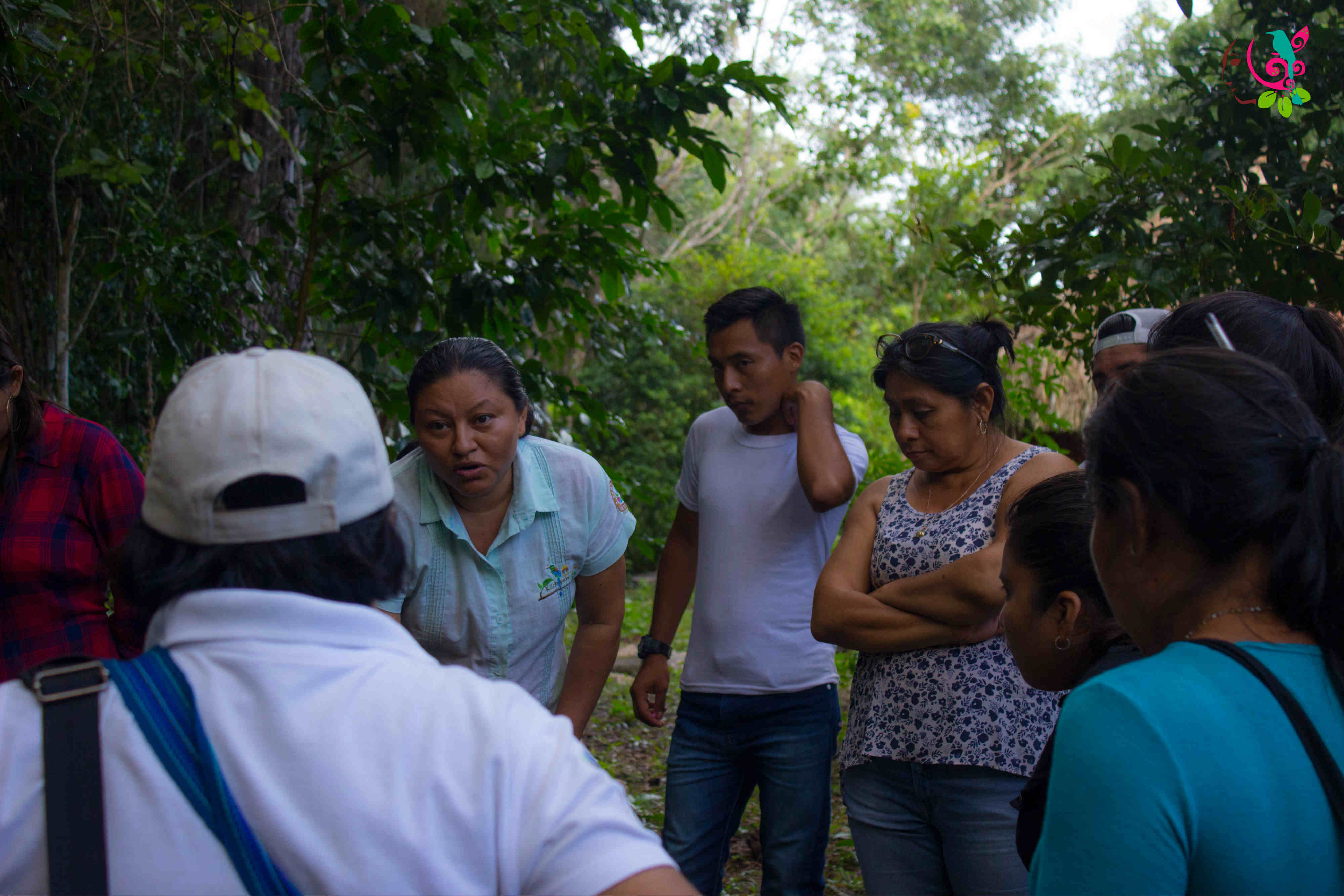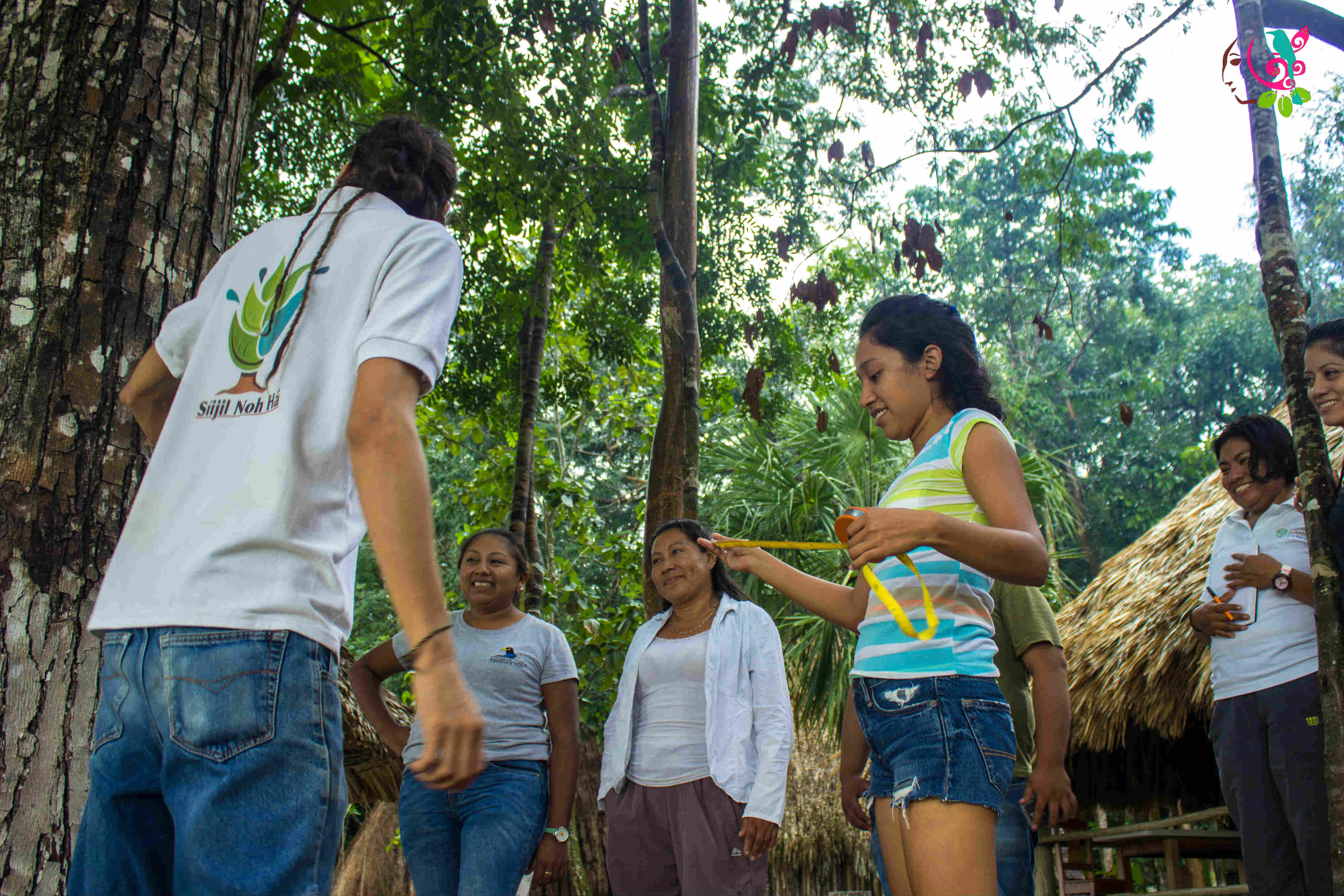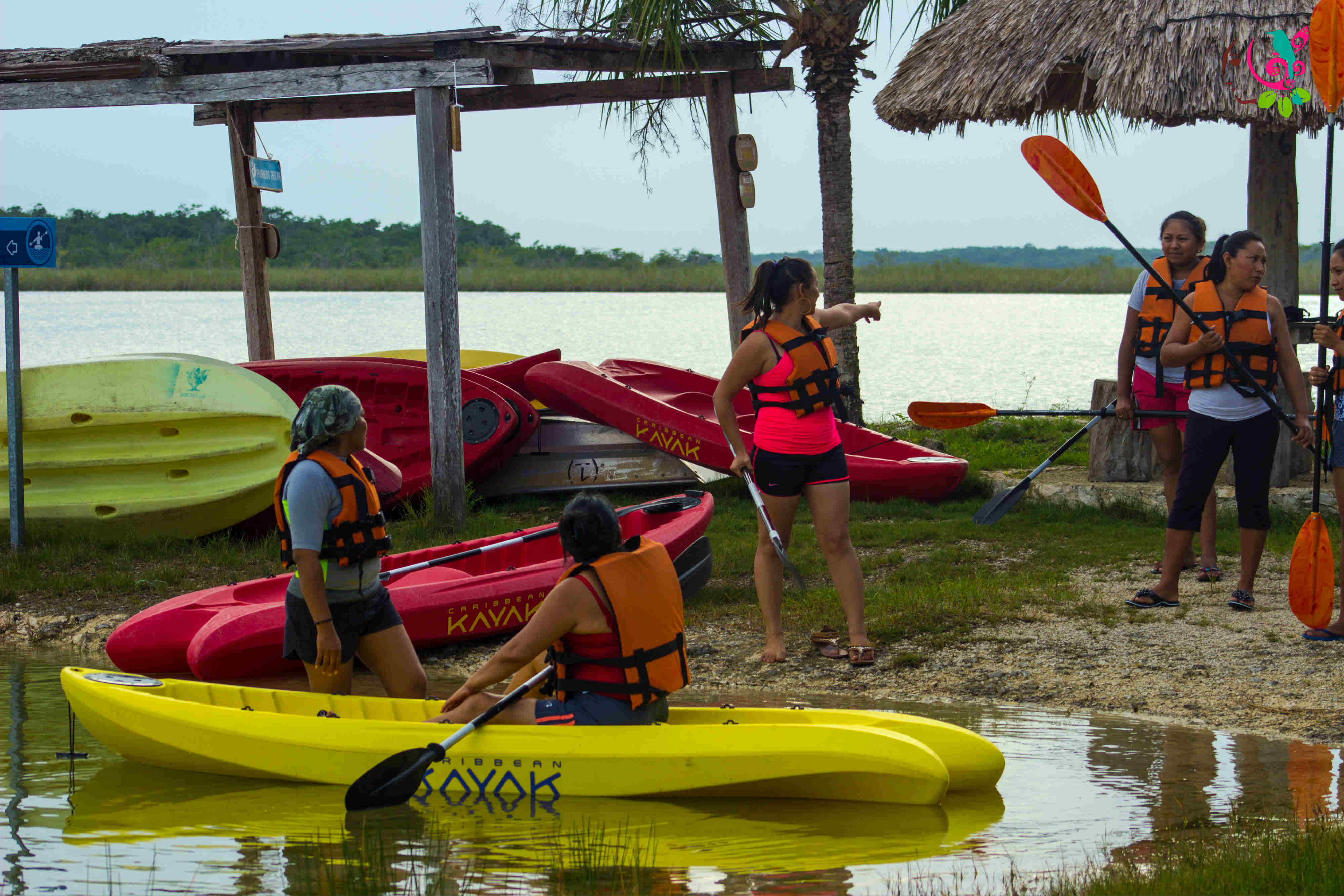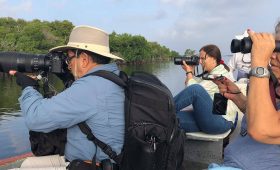Early on Tuesday October 2nd, the representatives of the cooperatives and the operative team that are part of Co’ox Mayab gathered to begin our trip to the center of Quintana Roo, where an experiences exchange with the Community-based Tourism Network of the Maya Zone of Quintana Roo awaited us.
The journey was delay free, a good mood prevailed within the group thanks to a perfect weather to travel. In a stop to pick up our colleagues of the cooperatives from the south of Yucatan we loaded a bunch of tangerines and bananas, that served to ease our trip to our destination.
After a few hours of travelling, we finally arrived at the community of Chunhuhub. Cellular coverage was intermittent and for long periods gone. It was fascinating not to have any coverage, but a bit tricky, because it wasn’t easy to find our destination and we had to make some calls.
Minutes later after going the wrong way, we arrived at our first destination: Ecotourism Center Kíichpam K’áax, where Zendy Euán, representative of Caminos Sagrados – Kili’ich Bejo’ob, gave us a warm welcome. We later settled in the comfortable cabins that were available there.
Kíichpam K’áax

Kíichpam K’áax means in English language pretty jungle, and it really lives up to its name. As soon as we were walking to the cabins, we could see the flora and fauna diversity that distinguishes this beautiful place. Birds, squirrels and also an alligator welcomed us.
Even though we were a bit tired, we regained our strength furing lunch. We went to the restaurant, where our food already awaited us. A delicious Sac Kool with a refreshing lemonade gave us the energy we needed to start the day’s activities.
“In our restaurant we seek to always serve food from the región. All the ingredients we prepare our meals with are organic and produced by us”, explained Margarita, the director of the eco-center, who also said that details like those are really appreciated by foreign visitors.
After we finished our meal, Margarite guided us a few meters away from the restaurant, where a path took us to her orchard. The wide variety of plants surrounding us started a discussion about the cuisine of the region, comparing the traditional dishes of Yucatan and Quintana Roo.
After a brief drizzle that cooled off the afternoon we went to a spot where a Trapiche was installed, a wooden mill used to extract sugar cane juice. The members of Co’ox Mayab showed their best skills to extract this sweet liquid, because a total of 4 fit people were needed to make the trapiche work manually.

Continuing with the tour through the eco-center, we arrived at a strategic spot for the development of the Xunáan Kaab, or Meliponas Bees, a beloved species throughout the Yucatan peninsula, due to the quality of the honey they produce.
While they were explaining to us about the importance of this species and the special care they need, insects could be seen entering and leaving without any concern on the spot where the bees inhabit and protect their honey.
At all times, caring for the environment was a topic to be addressed, since for both Kíichpam K’áax and for all the destinations that are part of Caminos Sagrados, ecology is a main issue and it has cost them a big to implement. Margarita and Zendy told us about the long history they had to go through to have the infrastructure of eco-technologies that they have today.
Photovoltaic panel systems and solar heaters could be seen in the area of cabins. “We save a lot of energy, there are seasons where generate enough electricity, that the surplus produced can be bought by the energy company,” they explained.

Some meters further, they taught us more about their facilities. A wastewater treatment system with wetlands and biodigesters, caught the attention of several of our colleagues, as they are tools that some Co’ox Mayab destinations have, always trying to provide a better ecological service.
The first day activities concluded with the presentation of the Community-based Tourism Network of the Maya Zone of Quintana Roo project, also known as Caminos Sagrados de Maya Ka’an.
The Network works in the Maya Ka’an area, located in the center of Quintana Roo, where they share experiences in natural environments, as well as promote the historical and cultural legacy of the Mayan people.
Zendy explained us that the network is integrated by eight different organizations, which are located in the communities of Chunhuhub, Kantemó, Muyil, Punta Allen, Señor, Tihosuco and Felipe Carrillo Puerto.

With much attention, the members of Co’ox Mayab took notes of the advices Zendy gave them about the strengths and weaknesses of the Quintana Roo Network, as well as the structure and organization of the project.
With much participation, night fell between dynamics and a question and answer session, to answer final doubts.
Amid the sounds of frogs, insects and other fauna that were present after the rain, we headed again to the restaurant. There we had a table prepared for making mojitos, which we sweetened with the juice of the cane we extracted.
After dinner, some ventured to walk in the dark to identify the different types of animals that were wandering around the area, while others chose to rest, because we expected another long day the next day.
Síijil Noh Há
The next day, and continuing with the itinerary, we left Chunhuhub to go to the heart of Quintana Roo; where Síijil Noh Há </ strong> is, a beautiful place located 10 kilometers south of Felipe Carrillo Puerto.
Located in the Much Kanan K’aax Common Lands Reserve, an impressive landscape that stars a big lagoon resplendent with the reflection of the midday sun, welcomed us to the Ecotourism Center Síijil Noh Há.
After going to the cabins to leave our belongings, we met Maria Eugenia Yam, representative of the organization, who was already waiting for us. And with tables set with refreshments, we were formally welcomed.
After the welcome and presentation, the biologist Omar Martinez made his appearance for a long talk on ecological issues, from initial concepts such as climate change to explaining very clearly the importance of the carbon footprint.
Without leaving an opportunity to fatigue, Omar continued sharing his experience with practical examples. After knowing the extent to which the trees capture carbon, we were the ones who measured the trees we found around us with growth tapes.

After a break that included a revitalizing lunch, we left the discussion where forest management was the theme; to continue, now with another topic, one that was of interest to the organizations that are part of Co’ox Mayab: the certifications.

Although again the rain threatened to stop our itinerary, nature behaved kindly and cleared the sky when we started our activities.
It was time to swim. Without exception, everyone was encouraged to explore the lagoon Síijil Noh Há, that means “where water rises”, because there’s a cenote that feeds, not only to that lagoon, but also others that are connected around the reserve.
And so the convoy of kayaks left the shore to tour the lagoon. Led by Omar, we arrived to where the cenote is, an “ojo de agua”, which caused a change in the water color where we traveled with our boats.
Excited, they offered us to explore the channels; where they don’t regularly give access to tourists, due to the species of birds that are nesting in the area.

Very carefully we entered a path in which we were instructed to paddle delicately, to not raise the mud that abounds in that territory. After dodging the vegetation throughout the road, we arrived to another lagoon that had a landscape like in the movies.
We took a moment to close our eyes and meditate in the middle of nature. The soothing sound of water, along with the singing of different bird species that were in the jungle, created a de-stressing moment.
Once back to the cabins, we took the opportunity to take a dip in the cenote, while some became competitive and held a kayak race to the shore of the eco-center, which was the finish line.
Due to the fatigue of the activities we did all day, the group preferred to sleep early, because the next morning we had to continue to a new sacred road of Maya Ka’an.

Early in the morning, some saw the sunrise and took beautiful photos of the landscape and the fauna that was in the place. As we were crossing the path we made several stops, since different types of birds could be heard, they were a challenge to identify, although we could see some ones like a collared aracari that was looking for food perched on a tall tree.
Xyaat
For the last day of the experiences exchange, we said goodbye to the Much Kanan K’aax Common Lands Reserve to head to the community of Señor. There we already expected Marcos Canté, who together with Zendy, lead the Xyaat project.
They introduced us to Don Crescencio Pat, a 95-year-old man who is one of the last witnesses of the Caste War of Yucatan and has much knowledge to share with visitors in Xyaat.
After a ceremony that Don Crescencio directed himself, we gathered to learn from him the manual work of the scraping of the henequen leaf and the manufacturing of sosquil (henequen fiber).

For the next activity transport was necessary. They guided us to the outskirts of Xyaat, where a line of moto-taxis already awaited us, which we boarded to visit the community of Señor, arriving at the home of Doña Teodocia Canché, a specialist in traditional Mayan medicine.
Collecting some leaves from her diverse garden, Doña Teodocia explained us how they deal with health problems, such as asthma, physical pain, and even insect bites.
The explanation of Doña Teodocia is in the Mayan language, but the guide Marcos translates without problems into Spanish for us, as he usually does with foreign visitors.
The translation was not so necessary, since most of the group understood and spoke Mayan language, which inspired confidence to the hostess to show us more of her medicinal secrets. It was time for everyone to take notes of everything possible, with pen and notebook in hand.

Back at the facilities of Xyaat, Zendy had prepared the last exchange session: Marketing strategies of the Quintana Roo Network.
A journey through the history of Caminos Sagrados enabled us to understand the first steps that can be executed to achieve a successful ecotourism project. Finishing up to clear the last doubts, we all ended up satisfied and proceeded to the farewell, but not without enjoying a delicious regional meal first.
With nostalgia we said goodbye to Quintana Roo, but first we thanked Zendy Celeste Euán for her attentions. She was our guide, companion and friend in all our tours. We thanked the team of the Community-based Tourism Network of the Mayan Zone of Quintana Roo as well, who with utmost professionalism made of our exchange an experience to remember and shared all their knowledge to improve together.




